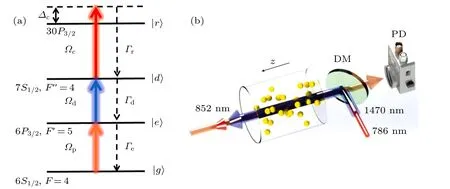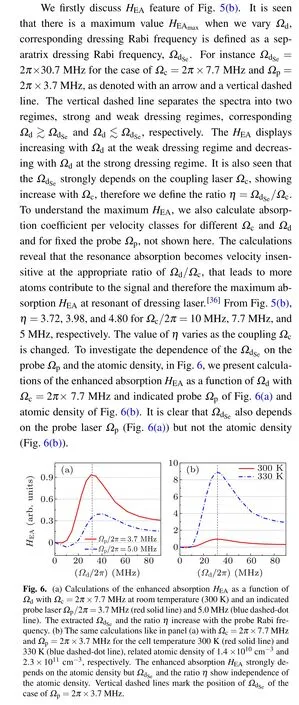Nonlinear spectroscopy of three-photon excitation of cesium Rydberg atoms in vapor cell∗
2021-03-19JiabeiFan樊佳蓓YunhuiHe何云辉YuechunJiao焦月春LipingHao郝丽萍JianmingZhao赵建明andSuotangJia贾锁堂
Jiabei Fan(樊佳蓓), Yunhui He(何云辉), Yuechun Jiao(焦月春),2,Liping Hao(郝丽萍), Jianming Zhao(赵建明),2,†, and Suotang Jia(贾锁堂),2
1State Key Laboratory of Quantum Optics and Quantum Optics Devices,Institute of Laser Spectroscopy,Shanxi University,Taiyuan 030006,China
2Collaborative Innovation Center of Extreme Optics,Shanxi University,Taiyuan 030006,China
Keywords: nonlinear spectroscopy,three-photon scheme,Rydberg state
1. Introduction
Nonlinear optical effects have played an important role in quantum optics and all-optical information processing,[1-4]especially in the field of atomic and molecular physics. A number of related techniques have been developed,including cavity coupling,[5-7]plasmas,[8]optical waveguide.[9,10]Recently,Rydberg atom has been exploited as a unique medium for investigating the nonlinear properties due to its extraordinary properties.[11]The strong long-range interaction (~n11, with n principal quantum number) between Rydberg atoms has been used to achieve single photon source,[12-14]single-photon transistor,[15]cooperative enhancement of nonlinearities,[16-18]which provides an important step toward nonlinearities in quantum computation,[19]quantum gate,[20,21]and quantum information processing.[22,23]Their large polarizability and microwave-transition dipole moment have been employed to achieve a giant dc Kerr coefficient[24]and to measure the electric fields of electromagnetic radiation with a large dynamic range.[25-28]
Rydberg state can be excited by a single-photon scheme using an UV laser,[29,30]but mostly by a two-photon excition[25,31,32]for higher excitation probability. Of these approaches, the double- or triple-frequency laser is required which is expensive and intricate. In an alternative way, a multi-photon scheme, such as a three-photon excitation with inexpensive and straightforward diode lasers,has caught one’s attention.[33,34]Recent experiments have demonstrated multiphoton transitions in atomic experiments,[35-37]and the nonlinear spectroscopy of Rydberg multi-photon excitation is becoming a hot topic in recent years.
In this work,we investigate,theoretically and experimentally, the three-photon nonlinear spectroscopy of cesium Rydberg atoms in a vapor cell employing electromagnetically induced transparency (EIT). The dependence of the Rydberg spectroscopy on the dressing laser Rabi frequency, Ωd, is investigated. The obtained three-photon spectrum exhibits an enhanced absorption (EA) signal at resonance of coupling laser and two enhanced transmission (ET) signals at detuned frequencies.The enhanced absorption(transmission)strength,HEA(HET), and distance between two ET peaks, γET, are defined to describe the spectral characteristics.The HEAis found to have a maximum value, corresponding dressing laser Rabi frequency is defined as separatrix, ΩdSe. Based on ΩdSe, the spectra are divided into two regimes,weak and strong dressing regime. The spectroscopies display different features at these two regimes. A four-level theoretical model is developed that agrees well with experimental results.
2. Theoretical model
We consider a four-level scheme, see Fig.1(a), consisting of a ground state |g〉, an excited state |e〉, a dressed state|d〉, and a Rydberg state |r〉. Probe laser drives the transition|g〉→|e〉,corresponding Rabi frequency of Ωp,while dressing(coupling)laser couples the transition of|e〉→|d〉(|d〉→|r〉)with Rabi frequency Ωd(Ωc). The probe transmission is detected with a photodiode(PD)detector,see Fig.1(b).
In consideration of the Doppler effect,the velocity selection can be written as follows:

where h is the Planck constant,Δiand kiare the detuning and wavenumbers of the lasers, respectively, and i=p,d,c. The Hamiltonian of four-level system can be expressed as


Fig.1. (a)Diagram of a four-level system. A probe light with wavelength λp and Rabi frequency Ωp, (a dressing light with λd and Ωd)is locked to the resonant transition of |6S1/2,F =4〉→|6P3/2,F′ =5〉 (|6P3/2,F′ =5〉→|7S1/2,F′′ =4〉). A coupling laser with λc and Ωc is scanned through the transition of|7S1/2,F′′=4〉→|30P3/2〉. Γe,Γd,and Γr are the decay of excited state,dressed state,and Rydberg state,respectively. (b)Sketch of the experimental setup. The coupling and dressing lasers co-propagate along z axis reflected with a DM, whereas the probe laser is set to counter-propagate to the coupling and dressing beams in the center of the cesium vapor cell. The spectroscopy of a four-level cesium atom is attained with a probe transmission detected with a PD detector as a function of the coupling laser detuning. PD:photodiode;DM:dichroic mirror.
The probe and dressing lasers are locked to the resonant transition|g〉→|e〉and|e〉→|d〉in the experiment, then we set Δp=Δd=0 in calculations. Considering the decay terms,we use the Lindblad equation to describe the evolution of the density matrix ρ as follows:

where L is the Lindblad operator considering decay term,

For convenience,we use the state basis{|1〉,|2〉,|3〉,|4〉}to represent {|g〉,|e〉,|d〉,|r〉}. ρkjis the density matrix element with k,j=1,2,3,4. Γi(i=e,d,r) denotes the spontaneous decay rate of |i〉 state. Here we do not include collision terms or dephasing terms due to the present study done in a vapor cell. The dephasing due to Rydberg-atom collisions can be decreased,for instance by reducing the laser intensities,decreasing laser beam waist and further the atom-field interaction time and using lower principal quantum number n,such as n=30 used here. In this work,we assume the decay|e〉to|g〉with the rate of Γe=2π×5.2 MHz,and decay rate of the state of|d〉and|r〉are Γd=2π×3.3 MHz,and Γr=2π×0.01 MHz,respectively.
The spectrum is given by the probe-power transmission,P=P0exp(−αL),with the probe-laser absorption coefficient,α =2π Im(χ)/λp,the cell length,L,and the susceptibility of the medium seen by the probe laser, χ. The susceptibility, χ,is

where N is the average atomic density, µ12is the dipole moment of transition|1〉→|2〉,Epis the amplitude of the probe,ε0is the vacuum permittivity, and ρ12is the density matrix element between|1〉and|2〉.

Fig.2. Calculations of cesium four-level atom with Ωp =2π×3.7 MHz,Ωd =2π×10.0 MHz, and Ωc =2π×7.7 MHz. Decay rate is taken as Γe=2π×5.2 MHz,Γd=2π×3.3 MHz,and Γr=2π×0.01 MHz,respectively. (a)Calculation of the probe absorption coefficient,α. The spectrum demonstrates an enhanced absorption at the coupling resonance, Δc =0,and two enhanced transmission peaks on both detuning sides. HEA (HET)displays the signal strength of enhanced absorption (transmission) and γET represents the distance between two ET peaks.(b)Populations of four levels ρ11 (black), ρ22 (red), ρ33 (blue), and ρ44 (purple)for |g〉, |e〉, |d〉, and |r〉states as a function of the coupling laser detuning Δc.

3. Experiments and discussion
The three-photon spectral experiment is performed with a room temperature cesium vapor cell, related experimental setup is shown in Fig.1(b). A coupling laser,λcand Ωc,and a dressing laser,λdand Ωd,co-propagate along z axis,which are combined with a dichroic mirror(DM).A probe laser, λpand Ωp,is set to counter-propagate with dressing and coupling lasers, see Fig.1(b). Three beams overlap with each other in the center of the vapor cell. The power of the probe beam passing through the cell is detected with a photodiode(PD)detector. The spectral signal is observed by measuring the transmission of the probe beam as a function of the coupling laser frequency.

Figure 3 presents measured spectra as a function of the coupling laser detuning,Δc,for the coupling(probe)Rabi frequency Ωc=2π×7.7 MHz(Ωp=2π×3.7 MHz)and three indicated Ωd.The spectra of Fig.3 clearly demonstrate the enhanced absorption on the coupling resonance point and two enhanced transmission peaks on both detuned sides.The spectral profiles agree with the theoretical simulations, see red solid curves of Fig.3. The deviation of the ET peaks of Fig.3 middle panel is attributed to a small shift of the dressing laser frequency in the experiment, that yields an asymmetric spectral profile at both sides of coupling detuning. It is seen, from Fig.3, that the ET peak strength, HET, and distance of two ET peaks, γET, show increasing with the dressing laser Rabi frequency Ωd, whereas the absorption strength, HEA, demonstrates increasing with Ωd,(middle panel of Fig.3),and then decrease after some value of Ωd,(bottom panel of Fig.3).

Fig.3. Measurements(symbols)and calculations(lines)of nonlinear spectra as a function of the coupling laser frequency at coupling Rabi frequency Ωc =2π×7.7 MHz and probe Rabi frequency Ωp =2π×3.7 MHz. The spectra demonstrate an enhanced absorption on the coupling resonance and two enhanced transmission peaks on both detuned sides of the resonance.

Fig.4. Spectroscopies of four-level cesium atoms of theoretical simulations (a) and experimental measurements (b) as a function of dressing laser Rabi frequency, Ωd, and coupling laser detuning, Δc. In calculations,Ωp=2π×3.7 MHz and Ωc=2π×7.7 MHz,Δd=Δp=0.
To understand the spectral feature above,we have carried out a series of theoretical calculations and experimental measurements such as in Fig.3. In Fig.4(a),we show calculations of absorption coefficient as a function of Ωdand Δc, where Ωpand Ωcare taken from experiments. For comparison, we present the measured spectroscopies in Fig.4(b),for the case of a fixed Ωp= 2π×3.7 MHz and Ωc= 2π×7.7 MHz,Δd=Δp=0. We found that both calculations and measurements of spectra display similar spectral feature, showing a good agreement. Close inspect of the Fig.4 reveals that the linewidth of ET peaks is invariant when Ωdvaries,and space between two ET peaks, γET, displays slight nonlinear dependence on Ωd.
From Fig.4,we extract the ET(EA)signal strength HET(HEA) and space of two ET peaks, γET, to characterize the spectroscopy of four-level atoms. Figure 5 presents measurements(symbols)and calculations(lines)of γETand HET(HEA)as a function of the dressing laser Ωdfor different coupling laser Ωc. It is found that the data of measurements are mostly sitting in the red lines,the case of Ωc=2π×7.7 MHz of calculations,demonstrating that the measurements are consistent with the calculations.



4. Conclusion

杂志排行
Chinese Physics B的其它文章
- Transport property of inhomogeneous strained graphene∗
- Beam steering characteristics in high-power quantum-cascade lasers emitting at ~4.6µm∗
- Multi-scale molecular dynamics simulations and applications on mechanosensitive proteins of integrins∗
- Enhanced spin-orbit torque efficiency in Pt100−xNix alloy based magnetic bilayer∗
- Soliton interactions and asymptotic state analysis in a discrete nonlocal nonlinear self-dual network equation of reverse-space type∗
- Discontinuous event-trigger scheme for global stabilization of state-dependent switching neural networks with communication delay∗
